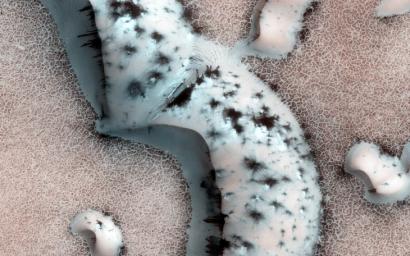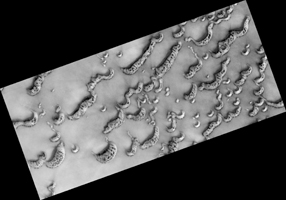
|
Shapes and Spots on a Polar Sand Dune
- Click the image above for a larger view
- Full-Res JPEG (2880 x 1800) (858.0 kB)
- Full-Res TIFF (2880 x 1800) (15.6 MB)
Caption:

Map Projected Browse Image
Click on the image for larger version
This image shows numerous dark shapes and bright spots on a sand dune in the Northern polar regions of Mars.
The bright spots are carbon dioxide frost. On Mars, the main atmospheric component is carbon dioxide, which circulates seasonally between the atmosphere and the polar regions. One of the reasons that permit this process is the fact that temperatures on Mars are much colder than on Earth, which allows carbon dioxide frost to condense on the surface in winter.
When spring comes however, the surface heats up and the carbon dioxide frost eventually sublimates (turns directly from the solid to the vapor state), and forms jets of carbon dioxide mixed with dust, leading to the formation of the dark features we see in the image.
Such processes occur seasonally on Mars, and therefore are continuously being monitored by the HiRISE scientists to assess the differences from one year to the next.
Background Info:
HiRISE is one of six instruments on NASA's Mars Reconnaissance Orbiter. The University of Arizona, Tucson, operates the orbiter's HiRISE camera, which was built by Ball Aerospace & Technologies Corp., Boulder, Colo. NASA's Jet Propulsion Laboratory, a division of the California Institute of Technology in Pasadena, manages the Mars Reconnaissance Orbiter Project for the NASA Science Mission Directorate, Washington.
Cataloging Keywords:
| Name | Value | Additional Values |
|---|---|---|
| Target | Mars | |
| System | ||
| Target Type | Planet | |
| Mission | Mars Reconnaissance Orbiter (MRO) | |
| Instrument Host | Mars Reconnaissance Orbiter | |
| Host Type | Orbiter | |
| Instrument | High Resolution Imaging Science Experiment (HiRISE) | |
| Detector | ||
| Extra Keywords | Atmosphere, Color, Dune, Dust, Map | |
| Acquisition Date | ||
| Release Date | 2014-02-22 | |
| Date in Caption | ||
| Image Credit | NASA/JPL-Caltech/Univ. of Arizona | |
| Source | photojournal.jpl.nasa.gov/catalog/PIA17928 | |
| Identifier | PIA17928 | |
